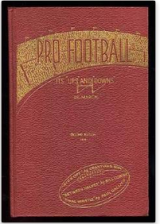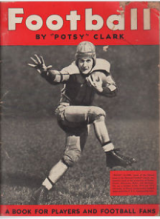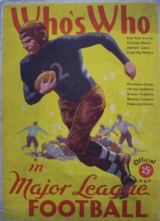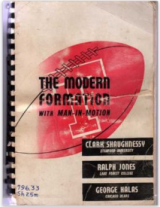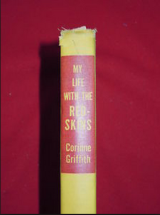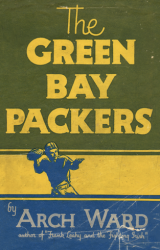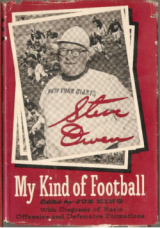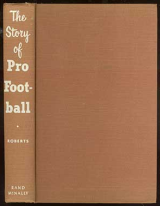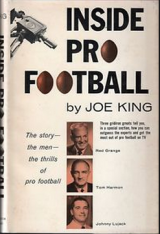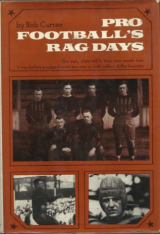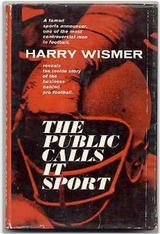Around the time his book on Bronko Nagurski was published in 2003, Jim Dent was sent to prison for violating his probation stemming from a felony drunk-driving conviction. Had anyone at his publishing house bothered to read the manuscript closely — line by line, “fact” by “fact” — it would have been clear that Dent was in rough shape, and that maybe Monster of the Midway should have been put in a drawer for a while until Jim (hopefully) got his life sorted out.
Alas, that didn’t happen. And so we’re left with a work that, in places, might be more fiction than non-fiction. I’ll lay out the evidence. You be the judge.
Before I go any further, let me just say that when I first heard Dent, author of the bestselling Junction Boys, was coming out with a book about the Bears’ famed fullback, I couldn’t wait to get my hands on it. Not nearly enough has been written about pro football’s early days, and Nagurski, of course, is legendary, arguably the greatest player in the single-platoon era.
But there was more to it than that. I was dying to see how Dent dealt with the obstacles I’d faced over the years — sparse newspaper coverage, precious few surviving game films and an increasing lack of eyewitnesses. The prewar period was vanishing fast. How did he manage to overcome that? Had he unearthed some sources I hadn’t?
The first time I cracked open Monster of the Midway, I found it a breezy read. Almost immediately, though, I wondered about the liberties Dent took in imagining conversations between Bronko, Bears owner-coach George Halas and others he couldn’t possibly have interviewed (unless it was via séance).
My eyebrows really went up when Dent wrote that in the first round of the 1939 draft, the Bears chose “a little-known tailback from Columbia named Sid Luckman.” Luckman was actually one of the most celebrated college players in the country. In November of his senior year, his dirt-smeared face had appeared on the cover of Life magazine, which had a huge circulation. He’d also finished third in the Heisman Trophy balloting, despite playing for a team that won just three games. Had the Bears not taken him with the second pick, his hometown Brooklyn Dodgers surely would have grabbed him at No. 5.
It wasn’t until recently, though, when I returned to the book to reread the section about the 1937 championship game, that I realized something disturbing: There are major discrepancies between Dent’s play-by-play and the one that ran the next day in The Washington Post. At some points, they seem like two different games.
Dent’s version: “Jack Manders’s opening kickoff was a line drive that slipped through the fingers of Cliff Battles and bounded between the legs of Ernie Pinckert. It was finally fielded by Max Krause at the one-yard line, where he was smothered by a pack of Bears.”
The Post’s version: “The toss was won by the Redskins and Captain Turk Edwards chose to kick off with the wind at his back. Nagurski took the ball on his own 1-yard line, slipped and fell, regained his feet and returned the kick to his 33, where Baugh bumped him out of bounds.”
But, hey, don’t take the Post‘s word for it. Check out this newsreel clip (that, in the pre-television age, was shown in movie theaters throughout the U.S.). For starters, it says, “Redskins kick off.” And yes, that’s Bronko fielding the ball, slipping on the frozen turf and returning to the 33.
According to the Post, Washington’s first possession came after “[Ray] Nolting punted outside” — that is, out of bounds — “on the Redskins’ 7-yard line.”
So there was no line-drive kickoff by Manders to start the game, no ball that glanced off Battles’ hands, bounced through Pinckert’s legs and was scooped up by Krause, who was tackled dangerously close to the goal line. That’s all . . . dramatization? Hallucination? The product of fuzzy memories? You tell me.
It matters for lots of reasons, not the least being that a famous play followed, one that saw Sammy Baugh line up in punt formation in the Washington end zone and surprise the Bears with a screen pass to Battles — at a time when screens were rare if not unheard of. The play gained 43 yards and started the Redskins on their way to a 28-21 upset victory. The play also foreshadowed what was to come in pro football: increasingly wide-open offenses that would throw the ball anytime from anywhere.
Here’s the clip of the screen. Note: The line of scrimmage is the 7, not the 1 (as Dent claims).
The ’37 title game was a watershed game for the NFL. Baugh, a rookie, racked up 335 passing yards that frigid afternoon — 29 more than the regular-season record. It would be nice, to the extent we can, to get the details right. Unfortunately, the game Dent “recreates” drifts in and out of reality.
After the Redskins took a 7-0 lead, he says, “The Bears responded in typical fashion. Nagurski carried the ball six straight times, all the way to the Washington 40-yard line. Then he tore through a large hole opened by Musso. One man stood in his path, and he was wearing No. 33. Nagurski lowered his shoulder and exploded into the rail-thin Baugh, sending him head over heels. The trainers came running out with smelling salts.”
The Post: “Edwards kicked off to Nolting, who ran the ball 20 yards to the Bears’ 28. Nolting made 2 yards at right end before Riley Smith nailed him. Justice replaced Pinckert in the Redskin backfield. Masterson passed to Manske, who made a shoestring catch in Baugh’s [safety] territory, slipped on the Redskins’ 40, regained [his footing] and ran to the Redskins’ 19 before Baugh brought him down. Nagurski swept around left end for 9 yards before Baugh bumped him down. Manders shot through a huge hole at right guard for 10 yards and a touchdown.”
Anybody notice Nagurski carrying the ball “six straight times”? Neither did I. The final statistics credit him with just eight rushing attempts total — three in the first quarter, four in the third and the last in the fourth (going by the Post‘s detailed account). Only once did he carry on back-to-back plays, never mind six in a row.
We move ahead to the third quarter:
Dent: “After the kickoff was returned to the 22-yard line, Baugh lofted a rainbow for [Wayne] Millner, who was 10 yards behind the Bears secondary and off to the races. The score was tied again [21-21].”
I ask you: Does it look in the following clip like Millner was open by 10 yards — or two?
Dent: “All eyes were on Millner as the Redskins drove deeper and deeper into Chicago territory late in the third quarter. Baugh jumped high in the air and pump-faked to Millner. With his feet back on the ground, Baugh pivoted and fired to a wide-open Ed ‘Chug’ Justice in the left corner of the end zone. The Redskins led 28-21.”
As you’ll see, Baugh didn’t jump “high in the air” when he pump faked before tossing the game-winning 35-yard TD pass to Justice. You’ll also see that, far from grabbing the ball in the “left corner of the end zone,” Justice caught it at the Chicago 18, in the general vicinity of the right hashmark, and ran it in from there.
Dent’s narrative, in other words, reads more like one of those Hollywood screenplays that’s “based on a true story.” He even dreams up this dramatic finish: “With only seconds remaining,” the Bears might have scored if receiver Les McDonald “hadn’t become tangled with back judge Ed Cochrane” on a 39-yard gain to the Washington 12. “By the time McDonald freed himself of Cochrane, Battles and Baugh were rushing up from behind. They caught McDonald just as the final gun sounded.”
This passage sets off all kinds of alarms, reeks of Too Good To Be True-ness. Not surprisingly, the Post, Chicago Tribune and New York Times — all of whom covered the game extensively — make no mention of McDonald’s run-in with the official. Seems like at least one of them would have.
Beyond that, though, this wasn’t the Bears’ last gasp. They ran four more plays in that series (two runs, a sack and an incomplete pass), lost the ball on downs, got it back again at their 42 and attempted two more passes, the second of which was intercepted. The Post’s play-by-play has the ball being snapped 16 times after the pass to McDonald — six by the Bears. (And the Bears would have had more chances, presumably, if they hadn’t fumbled a punt a short time later and enabled the Redskins to keep possession a while longer.)
It’s enough to make you question just about anything Dent says — with good reason, perhaps. Two more head-scratchers from earlier in the book:
Dent: “On October 4, Nagurski came off the wrestling circuit and arrived at [Pittsburgh’s] Forbes Field about an hour before kickoff. He had yet to practice with the Bears all season.”
Not true. According to the newspapers, he joined them a week before their Sept. 19 opener at Green Bay and played in that game and a non-league charity game two days later in Duluth, his old stomping grounds. Then he went back to wrestling for a while.
Dent: “[Nagurski] carried 15 straight times on one drive [against Pittsburgh] that led to a touchdown pass from Bernie Masterson to Stinky Hewitt.”
Lord knows where the “15 straight times” comes from. The Chicago Tribune had Bronko down for 10 carries in the entire game. Also, the TD — the only score in the 7-0 Bears victory — came not on a pass but on a 13-yard run by Nolting. But here’s the best part: Bill “Stinky” Hewitt, Masterson’s alleged target, was no longer with the Bears. Halas had traded him to the Eagles before the season.
Have I made my point? Monster of the Midway never should have seen the light of day — not then, anyway. It was too turbulent a time for Dent. (I’m going to assume — and it may be ill-advised — that he hasn’t always been so fast and loose with the facts.) As the Dallas Observer reported the year the book came out:
Instead of traveling here and there for autograph sessions and meeting with interviewers eager to help boost sales of his latest book, . . . he’s awaiting word of which Texas prison unit he’ll soon be assigned to, wondering what manner of career might be left to him.
Then again, maybe Dent couldn’t be saved at that stage — by family, friend or publisher. He told the Observer in a phone call from jail: “I wasn’t ready to listen to anyone. I was too damn stubborn. I’ve been an alcoholic for years, one of those who had to hit rock bottom to wake up.”
The Observer also quoted him saying: “It hurts to know that I’ve got what I believe to be a really good new book out there that I can’t promote. Oh, I’ve done a few radio interviews, things like that, but mostly what people want to talk about isn’t Monster of the Midway but me getting ready to go to prison.”
A really good new book. Yikes.
Of course, one of his editors, Peter Wolverton at St. Martin’s Press, sang much the same song. “What Jim has done with Junction Boys and his subsequent books,” he said in the Observer piece, “is create a new genre of sports book, taking milestone historical events and the people who participated in them to a new level of quality.”
A new level of quality. His exhumation of The Great Bronko suggests otherwise.
In his hard-partying days, Dent had an “image as the Robert Downey Jr. of Texas sportswriters,” according to The Dallas Morning News. The actor, who plunged into a similar abyss (alcohol, prison, etc.), has made quite the comeback since confronting his demons over a decade ago. Dent seems intent on doing likewise. Paroled in 2005, he has cranked out five more books — the latest of which, Johnny Manziel’s Glory Run, will be released in September.
Can’t say I’ve read any of them yet. I’m still in recovery from Monster of the Midway. But they say time heals all wounds. . . .

